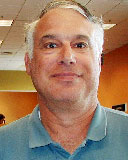 |
Joe Marasco is the author of The Software Development Edge: Essays on Managing Successful Projects, published by Addison Wesley in 2005. His interests include modeling organizational behavior to improve performance and profitability. For more information about consulting and on-site seminars, contact Joe at joe@barbecuejoe.com. You can learn about Joe's fascinating variety of interests by going to his web site at www.barbecuejoe.com.
|
Editor's Note
As you may gather from the name of Joe's web site, one of his passions is serving a great variety of mouth-watering barbecue dishes. However, that is far from his only interest. Another is Nomography, and in case you don't know it, a nomograph, also called a nomogram, is a graphical calculating device, i.e., a two-dimensional diagram designed to allow the approximate graphical computation of a function.[1] As Joe notes on his web site:[2]
"Back in the days of ships of wood and men of iron, there was a simple solution to the problem of having people obtain results from relationships in equation form. In those days, most non-technical people were daunted by 'plugging in numbers' to get answers; often, they would use the wrong system of units, use '25' for 'twenty-five per cent' where '0.25' was the appropriate input, and so on. If the equations involved several variables, tables became unwieldy. And implicit solution, or 'working backwards,' was almost unthinkable.
This was a task that was easy (although still error prone) for professionals, yet very hard for others. The typical boundary that needed crossing in those days was going from the design engineer in his office to the machinist on the shop floor. Today we have pocket calculators and personal computers with spreadsheets, but the barrier still exists.
Necessity required a simple, elegant solution. As is usually the case in such situations, graphics came to our rescue."
So what does all that have to do with project management, you may ask? Well, as a project manager, have you ever been asked about half way through, or later, to bring forward the completion date to meet some arbitrary time constraint to satisfy the wisdom of higher authority? What to do? What are your options?
Of course, the first option is to cut some scope. But if that is not acceptable, then you can work more overtime. But your team is already nearly burned out by working overtime as it is, and more of the same will simply "sink the ship". So the next option, likely, is to add more members to your team. But will that solve the problem? Possibly, but not necessarily, it all depends on the circumstances.
As Joe puts it:
"We can arrange 58 million transistors on a chip. Why can't we put 58 people on a project?"
1. For nomograph or nomogram see https://en.wikipedia.org/wiki/Nomogram, accessed August 13, 2015.
2. See www.barbecuejoe.com/scan.htm.
|



